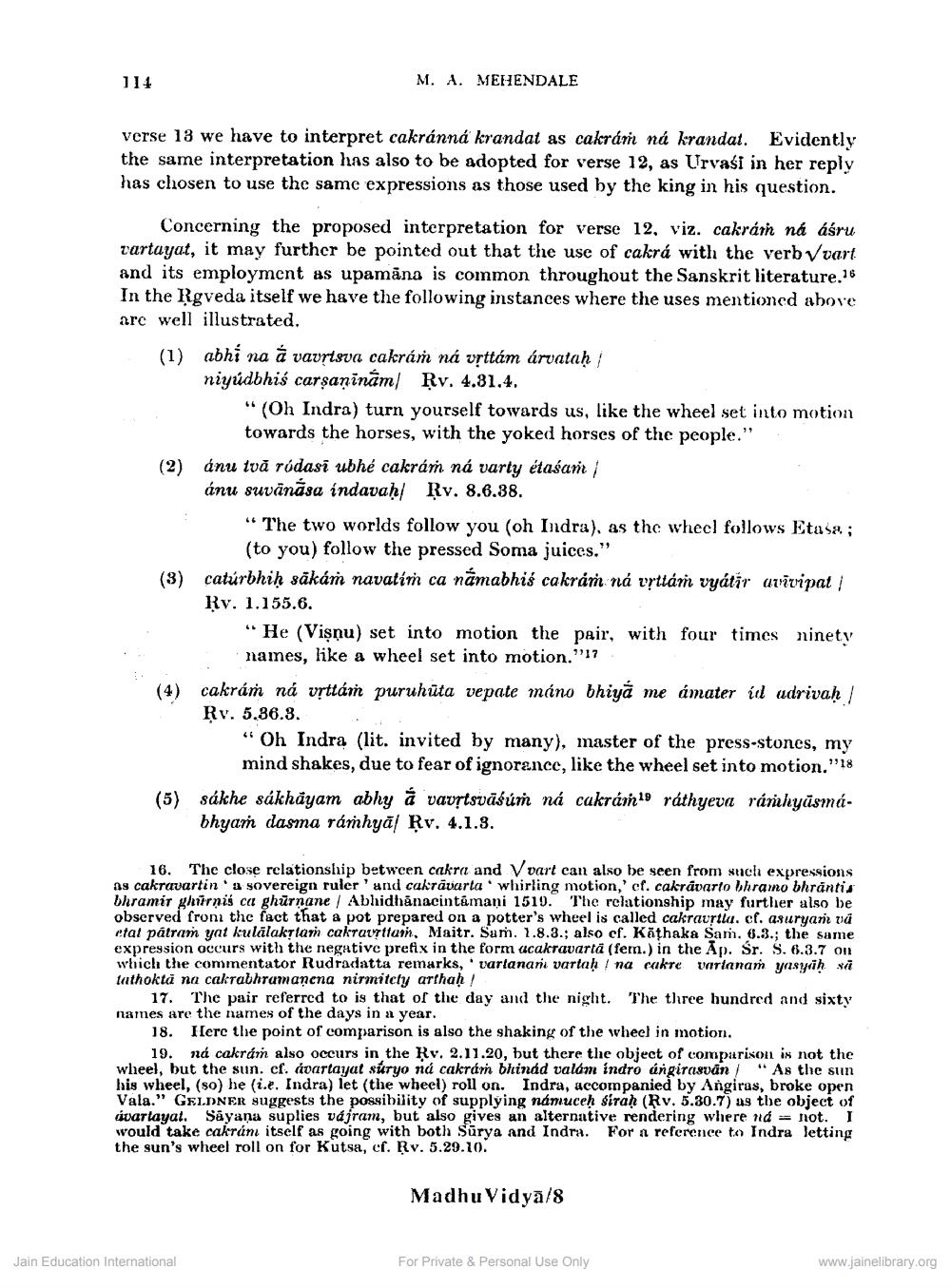________________
114
verse 13 we have to interpret cakránná krandat as cakrám ná krandat. Evidently the same interpretation has also to be adopted for verse 12, as Urvaśl in her reply has chosen to use the same expressions as those used by the king in his question.
M. A. MEHENDALE
Concerning the proposed interpretation for verse 12, viz. cakrám ná áśru vartayat, it may further be pointed out that the use of cakrá with the verb vart and its employment as upamana is common throughout the Sanskrit literature,1 In the Rgveda itself we have the following instances where the uses mentioned above. are well illustrated.
(1) abhi na à vavrtava cakrám ná vṛttám árvataḥ
niyúdbhis carṣaṇinám Rv. 4.31.4.
(2)
"(Oh Indra) turn yourself towards us, like the wheel set into motion towards the horses, with the yoked horses of the people."
ánu tvă ródasi ubhé cakrám ná varty étaśam | ánu suvanäsa indavah Rv. 8.6.38.
"The two worlds follow you (oh Indra), as the wheel follows Etasa; (to you) follow the pressed Soma juices."
(3) catúrbhih säkám navatim ca namabhis cakrám ná vyttám vyátir avivipat Rv. 1.155.6.
"He (Vişnu) set into motion the pair, with four times ninety names, like a wheel set into motion."17
(4) cakrám ná vṛttám puruhūta vepate máno bhiya me amater id adrivaḥ Rv. 5.86.3.
"Oh Indra (lit. invited by many), master of the press-stones, my mind shakes, due to fear of ignorance, like the wheel set into motion."
ráthyeva rárishyamá
(5) sákhe sákhayam abhy a vavṛtsväáúm ná cakrám
bhyam dasma rámhya Rv. 4.1.8.
16. The close relationship between cakra and Vvart can also be seen from such expressions as cakravartin a sovereign ruler' and cakravarta whirling motion,' ef. cakravarto bhramo bhrantis bhramir ghurnis ca ghurnane / Abhidhanacintamani 1519. The relationship may further also be observed from the fact that a pot prepared on a potter's wheel is called cakravṛtia. cf. asuryam vā etat patram yat kulalakṛtam cakravrttam, Maitr. Sam. 1.8.3.; also ef. Kathaka Sam. 6.3.; the same expression occurs with the negative prefix in the form acakravarta (fem.) in the Ap. Sr. S. 6.3.7 ou which the commentator Rudradatta remarks, varlanan vartaḥ na cakre vartanam yasyaḥ sā tathokta na cakrabhramanena nirmitety arthaḥ!
Jain Education International
17. The pair referred to is that of the day and the night. The three hundred and sixty names are the names of the days in a year.
18. Here the point of comparison is also the shaking of the wheel in motion.
19. ná cakrám also occurs in the Rv. 2.11.20, but there the object of comparison is not the wheel, but the sun. cf. avartayat suryo ná cakrám bhinád valam indro úngirasvan "As the sun his wheel, (so) he (i.e. Indra) let (the wheel) roll on. Indra, accompanied by Angiras, broke open Vala." GELDNER suggests the possibility of supplying námuceḥ sirah (Rv. 5.30.7) as the object of ávartayat. Sayana suplies vájram, but also gives an alternative rendering where nd not. I would take cakram itself as going with both Surya and Indra. For a reference to Indra letting the sun's wheel roll on for Kutsa, cf. Rv. 5.29.10.
Madhu Vidya/8
For Private & Personal Use Only
www.jainelibrary.org




